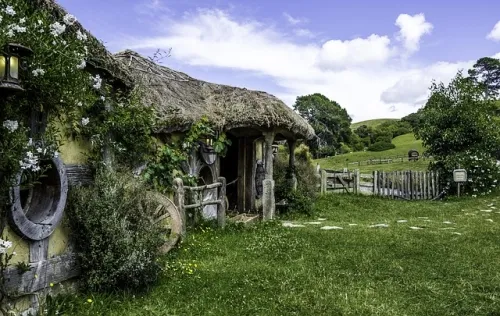
Review: Tales Of The Shire: A The Lord Of The Rings Game (Switch)
A Lord of the Rings comfort game? Crafted by Weta Workshop, the very team behind the props, sets, and outfits in Peter Jackson’s cherished trilogy? All the hype, right?
Regrettably, Tales of the Shire is less the cosy hobbit-haven we’d prayed for and more a showcase of development practices that short-changed staff and gamers alike. Those developers still deserve credit for what they managed to salvage though—so we’ll begin there.
The adventure kicks off—unsurprisingly—with a quick, slightly corny Gandalf walk-on. After that, your hand-crafted, big-footed halfling is dumped in a dusty burrow to “settle in.” Old Ruby’s former home looks nothing like the twee hobbit hole of our dreams: the door is busted, gates lie splintered on the ground, and stray logs clutter the yard. Still, no comfy sim would be complete without a little pixellated grunt work.
Gradually, while you patch up the cottage, you’ll master angling, foraging, tilling, cookery, and village diplomacy as Bywater strives to become a fully recognised settlement—and you’re their quest-giving poster child.
Preparing food dominates Tales, and the mechanics are the deepest of the lot. Every plate is plotted on twin spectrums—hearty/creamy and crunchy/soft—plus four taste nodes: sweet, salty, bitter, and sour. Chopping, stirring, searing, and spicing must all be juggled in tandem with top-notch produce if you want your new hobbit mates truly charmed.
Big surprise: the path to a hobbit’s affections is meal-shaped. This theme culminates in Shared Meals—the emotional core of the game—which boost rapport, drip-feed fresh recipes, and sprinkle nuggets of trivia about your neighbours. Sadly, the locals as a whole feel thinly sketched; though the writing’s sharp, none radiate the heart of a Sam, Merry, or Pippin.
In truth, these halflings skew testier: snub a meal request and you’ll soon bag a passive-aggressive letter. Persist in neglect and they’ll pout. Nobody ever invites you to dinner, either. Manners, people.
The cookery-adoration pipeline is fiddly yet vital—and once the rhythms click, spinning all those figurative plates becomes oddly joyful. The downside? You can’t sell plates, which is awkward when money is tight. A pitiful ten-slot starting backpack plus wildly inflated prices for essentials you can’t craft yourself foster an economy as wobbly as a barley-twist bridge.
Growing veggies is simpler yet instantly engaging: each seed demands elbow room, so you’ll thread radishes between cauliflowers with pixel-perfect precision—satisfying when it works. Companion planting adds another layer, letting you eke out premier yields. A flawless garden bed feels like handmade geometry.
Interior make-over is similarly streamlined: pick a few cosy palettes (oak or pine tones, cheery walls, elegant brick), pop lamps in nooks, dot plants along corridors, then scatter tasteful Dwarven furnishings. Within hours the hovel looks worthy of Bagshot Row.
But none of this can escape the shadow cast by the glitches.
A normal Bywater morning: your hobbit opens her eyes; the frame-rate instantly lurches like Pippin chugging an ale. She skips toward the Green Dragon only to find ten NPCs wedged together outside in a hairy traffic jam. Duck into a shop and the screen greys out save for one tiny corner, so navigation is achieved via postage-stamp vision.
Next, a woodland stroll: on the path she passes a texture-less hobbit talking to thin air; suddenly the sky washes blood-red (complete with black blotches) for minutes before returning to normal for no reason. Scramble back to do some angling only to discover the ui vanished and the joy-con buzzing like a jar of bees and rice. Finally she trudges home, but at the thirty-minute mark—*crash!*
Several of those disasters have been patched (20 freezes in ten hours finally dropped to zero after one update), yet crashes still happen, textures pop late, and performance drags mercilessly. On Switch it also looks rough (see the images) with shrubs and rabbits blinking into existence a foot from your nose. More fixes are likely, but the laundry list is long.
In the end, Tales of the Shire is the same old cautionary yarn: a mismanaged project shoved out unfinished, flouting both players and creators who plainly adored it. Reports from within cite inexperience, shifting mandates, layoffs, publisher shutterings, brutal crunch, and chronic under-staffing. All of this produced a game that’s confusing on a good day, near-unplayable on a bad one, and almost certainly wasn’t worth the human toll. Enjoyment curdles when the making-of story is this grim. Until the industry stops devouring talent instead of nurturing it, this story will keep replaying on loop. And that’s not cosy in the least.
Verdict
Snug halflings in a slice-of-life wrapper sounds like a pitch straight from Valinor, and Tales of the Shire strains toward that dream. Right now, though—especially on Switch—it’s less a warm cuddle and more a long trudge across Mordor carrying dodgy jewellery.
